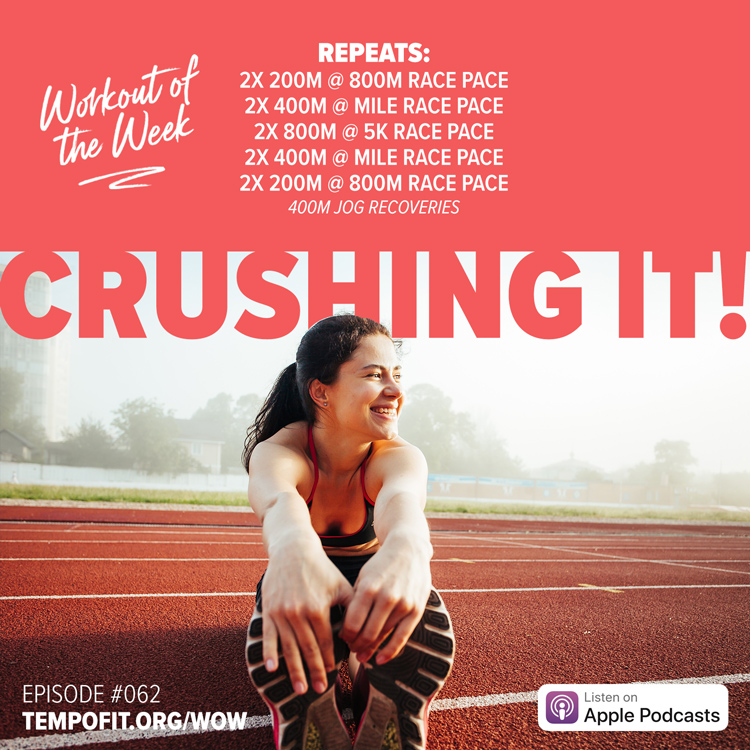
To finish our month of repeat track workouts, this is an honest session in a ladder-style in order to go fast at the start and end and throw in some aerobic work in the middle.
WHAT?
2x 200m @ your 800m race pace
2x 400m @ your mile race pace
2x 800m @ your 5k race pace
2x 400m @ your mile race pace
2x 200m @ your 800m race pace
Recovery: 400m jogs
Terrain: A track (or measurable path).
Feels: Crushing It!
This is a good solid workout where the 400m recovery jogs play a crucial role in making sure you’re staying smooth and in control in the back half of the workout. If you’re new to this sort of session, just do one rep of each (instead of two) or downgrade the paces to mile to 10k race effort.
WHY?
This workout has 4k worth of work at mile pace or faster, so it is honest and will be challenging. It’s this combo of both quality and quantity that makes these types of sessions more an occasional session than a regular go-to.
HOW?
Like we’ve been doing all month long with the repeat workouts, the recoveries are super important to make sure you’re ready to go to express good technique and speed each rep. Take more than 400m if you need it.
If you’re new to this sort of training, either to the speed or the quantity, be sure to dial back one of these elements. Either just do one of each rep (instead of two) or scale back the speeds by doing the 200s at mile pace, the 400s at 3k/5k pace, and the 800s at 10k race pace.
THOUGHT FOR THE WEEK:
THE WHAT, WHY & HOW OF RECOVERY RUNS
When you’re doing lots of taxing track sessions, you need to make sure that most of your other running (on non-workout days) is chilled and act as genuine recovery runs. These promote blood flow while contributing a little more aerobic development.
Here are some tips on how to nail recovery runs in those demanding training weeks.
- Keep It Conversational. If you can easily talk the whole way through a recovery run it’s a really good gauge to make sure you’re staying below your lactate threshold. As such it can be a really good idea to plan to have company for your recovery runs (assuming your running buddies are also in recovery mode!).
- Start Slow, End Easy. One of the biggest mistakes I see from newer runners is starting every run too fast, even to the point that their first KM is their fastest for the run. To avoid accumulating early fatigue, it should be the opposite. Instead, start with a walk, maybe some dynamic stretches and then ease your way into it. And on a recovery run you’ll just gradually increase the pace throughout the run but still finish well within your “easy” range.
- No Strain. I have to emphasise this again, that recovery runs should have ZERO moments where you’re pushing things. Sometimes when we’re doing “easy” runs we can just push a little up a hill or dash across the street. But recovery runs are so chilled out that you’ll instead opt to just walk the steep hills and wait at the traffic lights more often than not.
- Combine With Other Active Recovery. Recovery runs by nature can’t be super long (they typically need to be an hour or less) so they can allow some time towards other recovery activities such as foam rolling, yoga, walking, swimming or deep water running, and cycling. These should all be equally chilled and “easy” but the variety of movement can add a further dimension to your active recovery.
Podcast (workout-of-the-week): Play in new window | Download
Subscribe: Apple Podcasts | RSS | More



